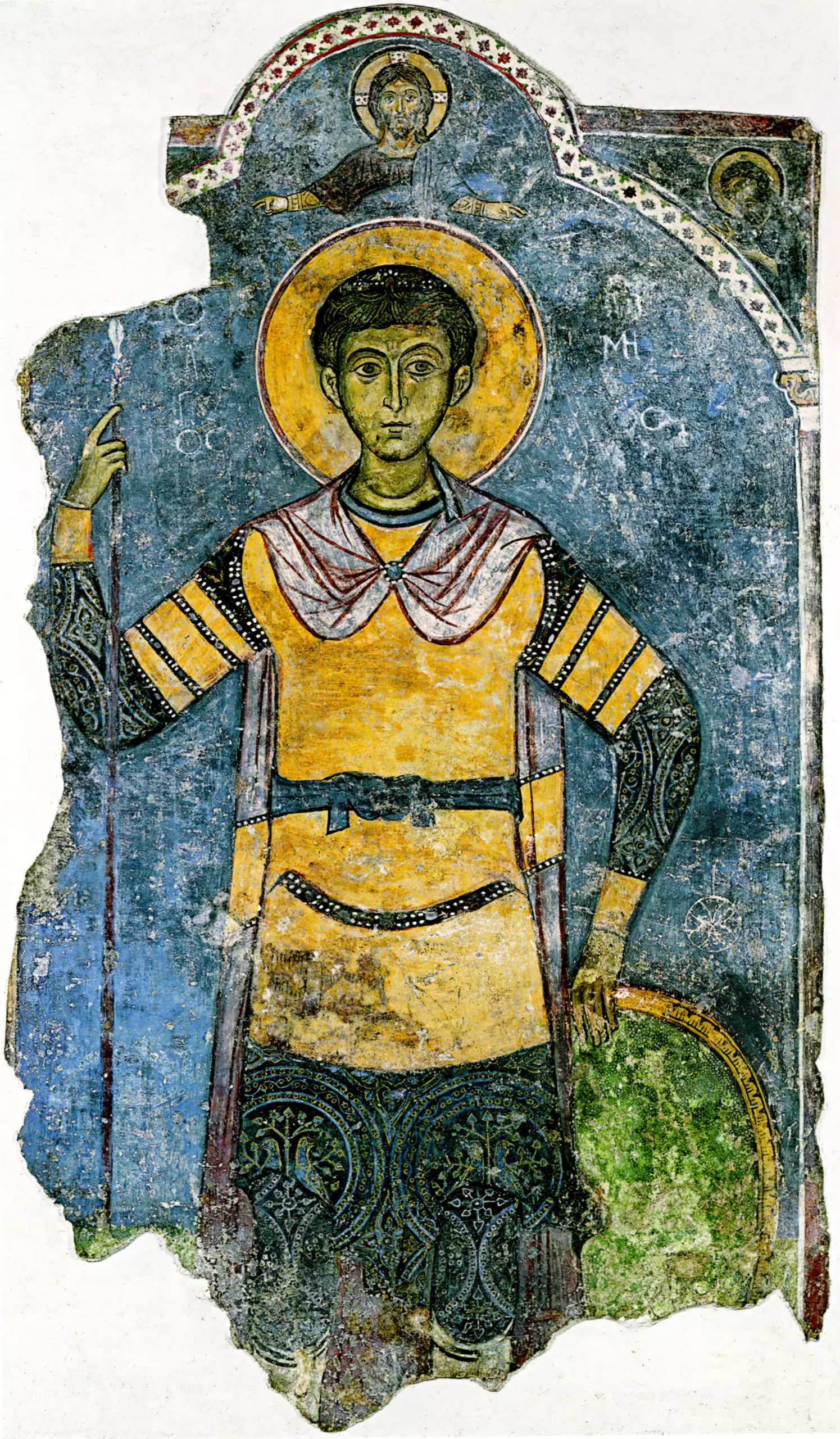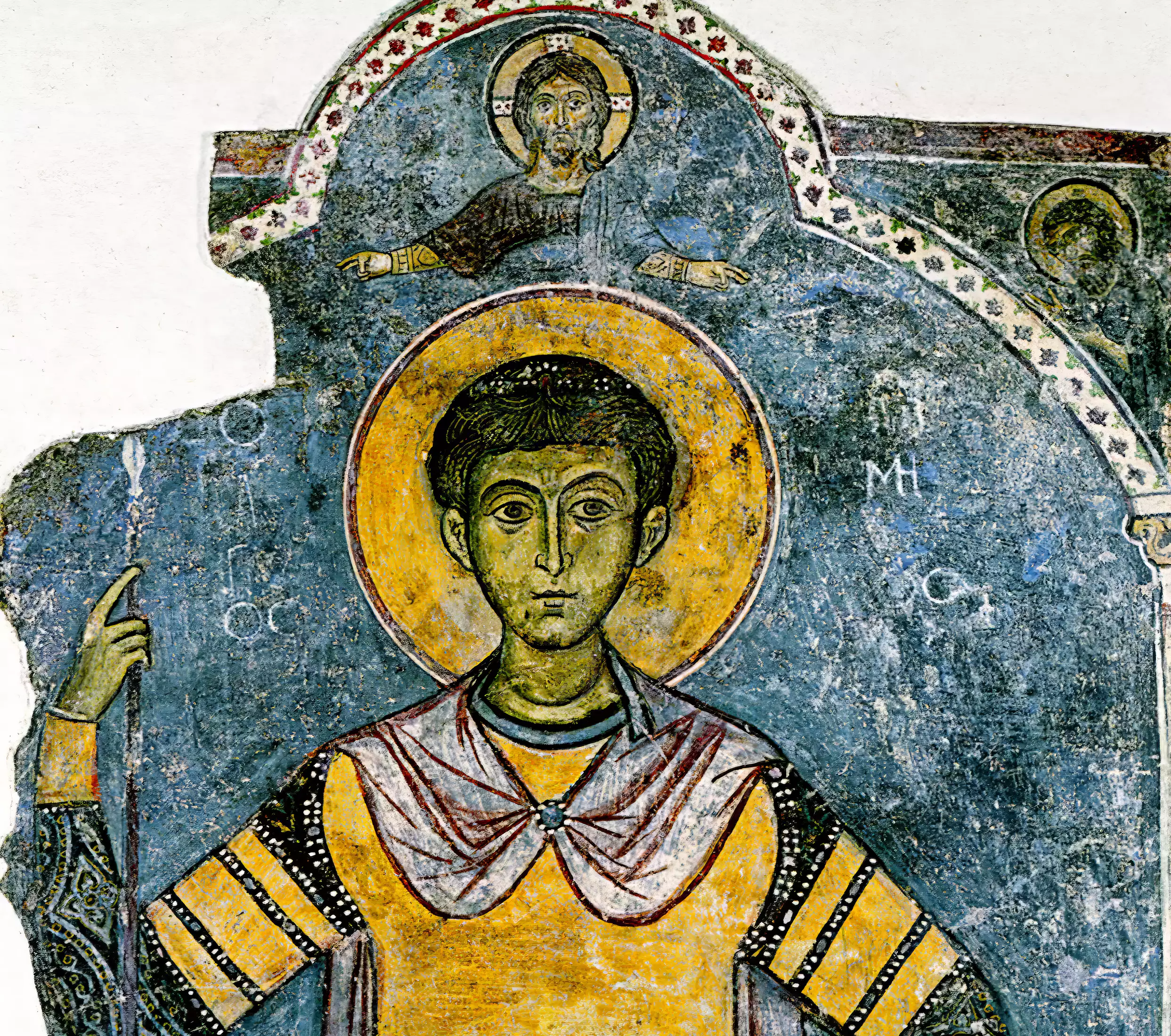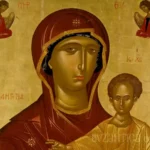Larnaca fresco of St Demetrios
Title: Saint Demetrios Fresco
Artist Name: Unknown Byzantine Master
Genre: Wall Painting/Religious Art
Date: 13th century AD
Dimensions: 222 x 131 cm
Materials: Fresco on plaster
Location: Kykkos Monastery Museum (originally from Church of Agios Antonios, Kellia, Larnaca)
Sacred Warrior in Azure and Gold
The fresco draws me in with its striking balance of earthly might and heavenly grace. Standing before it, I’m caught by Saint Demetrios’s steady gaze – both commanding and contemplative. The artist has created something extraordinary here: a military saint who bridges the physical and spiritual realms.
The colors tell a rich story. The deep blue background sets a supernatural stage, while those brilliant golds in the halo and military dress catch light like sun on polished bronze. I notice how the yellow ochre of his tunic plays against the azure, creating depth and warmth. Those geometric patterns on his military costume – each one carefully picked out – show amazing attention to detail.
As A.H.S. Megaw notes in his study of Byzantine architecture and decoration in Cyprus, this kind of technical sophistication in 13th century Cypriot art reflects both metropolitan influences and local artistic traditions: “The quality of execution varies considerably, but at its best the painting maintains a high standard comparable with contemporary work in the capital.”
What really strikes me about this piece is how it captures two aspects of sainthood. The face shows youth and strength, but there’s also this profound spiritual gravity in the expression. The military garb includes precise details of armor at the shoulders, yet the saint’s pose suggests peaceful authority rather than aggression. Looking closely at the face, I can see how the artist built up subtle layers of color to create lifelike depth – it’s masterful technique.
The damage visible at the edges of this fresco fragment only makes what survives more precious. Those patches where the plaster has crumbled remind me that we’re looking at something that has endured centuries. The colors remain remarkably fresh in the central portion – the blues especially have kept their intensity. I find myself wondering about all the generations of faithful who’ve gazed up at this image, seeking protection and inspiration from this warrior-saint.
The composition itself is beautifully balanced. The arched frame echoes the curve of the halo, creating this sense of harmony between earthly and heavenly spheres. And while the pose is formal, there’s movement in those draped fabrics and a lightness in how the saint raises his hand in blessing.
The more time I spend with this piece, the more details emerge. There’s such richness in those decorative borders – each pattern carefully planned and executed. The artist knew exactly how to use color and line to guide the eye upward, from the solid earthly stance through to that radiant halo connecting the saint to heaven.
Symbolism and Style in the Medieval Sacred Space
In studying this remarkable fresco, I’m struck by the seamless blend of spiritual and martial elements. The artist pays special attention to Saint Demetrios’s military attire, yet manages to infuse it with sacred significance. Each detail of the costume speaks to both earthly authority and divine protection.
J Andrews, in his examination of visual culture in medieval Cyprus, points out how such military saints held particular significance in Byzantine Cyprus: “The visual representation of warrior saints reflected both the spiritual and political aspirations of the island’s elite, creating a complex web of devotional and social meanings.”
What’s particularly fascinating is the distinctive treatment of space. The artist has crafted a spiritual hierarchy through the clever use of perspective. The main figure commands the central space, while above, the curved architectural frame creates a sense of heavenly presence. This spatial arrangement wasn’t just artistic choice – it reflected deep theological ideas about the relationship between heaven and earth.
T Papacostas discusses how such artistic choices in medieval Cyprus reflected a unique cultural synthesis: “The integration of Byzantine artistic traditions within local architectural contexts produced distinctive expressions of sacred space.”
Looking at the paint surface itself, I notice subtle variations in texture that speak to the artist’s technique. The blue background shows different densities of pigment – thicker in some areas, allowing the underlying plaster to show through in others. This creates a kind of atmospheric effect that makes the saint appear to float between earthly and heavenly realms.
The handling of the face particularly draws my attention. The artist has built up the features with remarkable sensitivity, using careful gradations of color to create a sense of both physical presence and spiritual transcendence. The eyes especially carry a profound psychological weight – they seem to look both at and through the viewer.
I find myself wondering about the specific devotional practices this image would have inspired. The positioning of the saint’s hands – one raised in blessing, the other possibly having held a now-lost attribute – suggests an active relationship between image and worshipper. This wasn’t just a portrait; it was a point of contact between the human and divine.
The technical skill evident in the drapery handling amazes me. The artist understood how to use light and shadow to create convincing folds while maintaining the overall flatness appropriate to sacred imagery. This balance between naturalism and stylization is characteristic of the best Byzantine art.
Divine Protection and Military Might: Context and Meaning
The Larnaca fresco offers fascinating glimpses into the spiritual-military complex of medieval Cyprus. The detail in Saint Demetrios’s military costume catches my eye – those carefully rendered stripes on the shoulders aren’t just decorative. They mark him as a high-ranking military officer, yet there’s something deeply spiritual in how they’re depicted. The artist has transformed practical armor into symbols of divine protection.
Standing here, I can’t help noticing how the paint surface itself tells a story of time’s passage. Where the plaster has held firm, the colors maintain an almost shocking freshness. The blues especially – they must have been dazzling when first painted. But there’s beauty even in the wear. The fragmentary edges remind me that we’re looking at something that’s survived centuries of history.
The composition works on multiple levels – physical and spiritual. Saint Demetrios stands firm, grounded in his military bearing, but his gaze lifts upward toward heaven. The architectural frame isn’t just decorative – it creates a sacred space, setting the saint apart from the mundane world.
What strikes me most is how the artist handled light. There’s no single light source – instead, light seems to come from within the figure itself. The highlights on the face and hands are particularly subtle. They create this sense of inner illumination that speaks to the saint’s spiritual nature.
The background treatment deserves special attention. That deep blue isn’t flat – it has variations in tone that create a sense of infinite space. It’s as if the saint stands between heaven and earth, a mediator between divine and human realms. The artist understood exactly how to use color to create theological meaning.
The attention to facial features reveals remarkable psychological insight. The expression carries authority but also compassion – exactly what you’d want in a protective saint. There’s a tension between military strength and spiritual grace that the artist has captured perfectly. Looking at this face, I understand why people would have turned to this image in times of trouble.
The paint handling itself shows real mastery. In places where the surface is well-preserved, you can see how the artist built up layers to create subtle effects. The modeling of the face used thin glazes of color, while the military costume shows more direct, confident brushwork. This technical variety adds to the overall impact.
Spiritual Illumination: Analysis of the Saint’s Face Detail
Looking closely at this striking facial detail from the Larnaca fresco, I’m drawn to the masterful interplay of light and shadow that brings Saint Demetrios’s features to life. The artist’s technique here shows remarkable sophistication in modeling the face. The skin tones are built up through subtle layers, creating a naturalistic yet spiritualized presence.
The golden halo provides more than mere decoration – it creates a visual anchor that draws attention to the saint’s contemplative expression. The way it’s executed, with its perfect circular form against the deep blue background, speaks to the artist’s technical precision. Small indentations in the gilt surface would have caught candlelight, making the halo appear to shimmer in the church’s dim interior.
What fascinates me most is the psychological depth achieved in the face. The large, almond-shaped eyes dominate the composition, gazing outward with an intensity that must have deeply affected medieval worshippers. The artist has managed to capture both authority and compassion in that gaze – a difficult balance that speaks to high artistic skill.
The blue background shows extraordinary preservation in this detail. Its deep, mineral richness creates an otherworldly setting that emphasizes the saint’s spiritual nature. The artist used variations in the blue pigment’s density to subtle effect, creating an atmospheric quality that makes the face appear to emerge from divine space.
Looking at the paint handling reveals fascinating technical choices. The face shows careful modeling with thin glazes building up form, while the halo demonstrates more direct application of gold leaf or paint. This variation in technique helps distinguish between earthly flesh and heavenly radiance.
The architectural framing element visible at the top adds another layer of meaning. Its curved form echoes the halo’s shape, creating a harmonious composition that places the saint’s face at the focal point of converging sacred geometries. Even in this detail, we can see how every element works together to create a powerful devotional image.
Sacred Art as Living Heritage
The Saint Demetrios fresco from Kellia represents more than just artistic achievement – it opens a window into the spiritual and cultural world of medieval Cyprus. Standing before this work, I’ve attempted to unpack its layers of meaning while staying grounded in the physical reality of paint on plaster.
The artist’s technical mastery serves a higher purpose here. Each careful brushstroke, each subtle modulation of color works to create not just an image, but a presence. The deep blues of the background, the glowing gold of the halo, the sensitively rendered face – all come together in service of making the divine tangible.
This fresco challenges modern divisions between art and spirituality. Looking at how the paint was applied, studying the composition’s careful geometry, examining the integration of symbolic elements – these technical aspects can’t be separated from the work’s religious function. The artist’s skill made visible something that transcended mere representation.
What strikes me most, after spending time with this work, is its continuing power to move viewers across centuries. Though created for a medieval audience in a specific devotional context, it speaks to universal human experiences of seeking divine protection and guidance. The saint’s steady gaze still commands attention, still invites contemplation.
The technical and spiritual achievements preserved in this fresco deserve ongoing study and protection. Each surviving medieval Cypriot church painting adds to our understanding of this rich artistic tradition. Yet beyond their historical value, works like this remain vital – not just as artifacts, but as enduring expressions of human creativity in service of the sacred.
Unknown Byzantine Master of Kellia
The artist who created the Saint Demetrios fresco remains anonymous, like many medieval painters. Yet their work in the Church of Agios Antonios reveals exceptional technical skill and deep theological understanding. The refined modeling of forms, sophisticated use of color, and masterful integration of symbolic elements point to training in major Byzantine artistic centers.
Looking closely at the fresco’s execution, I notice hallmarks of 13th century Cypriot painting – the careful gradation of flesh tones, the geometric precision of the halo, the subtle atmospheric effects in the background. These techniques show an artist thoroughly versed in Byzantine artistic traditions yet capable of individual expression within those conventions.
© Byzantica.com. For non-commercial use with attribution and link to byzantica.com
The analysis presented here reflects a personal interpretation of the artwork. While based on research and scholarly sources, art interpretation is subjective, and different viewers may have varied perspectives. These insights are meant to encourage reflection, not as definitive conclusions.
Bibliography
- Andrews, J. “Conveyance and convergence: Visual culture in medieval Cyprus.” Medieval Encounters 18, no. 4-5 (2012): 413-441.
- Megaw, A.H.S. “Byzantine architecture and decoration in Cyprus: Metropolitan or provincial?” Dumbarton Oaks Papers 28 (1974): 57-88.
- Papacostas, T. “Byzantine Rite in a Gothic Setting: Aspects of Cultural Appropriation in Late Medieval Cyprus.” Series Byzantina 8 (2010): 117-132.


